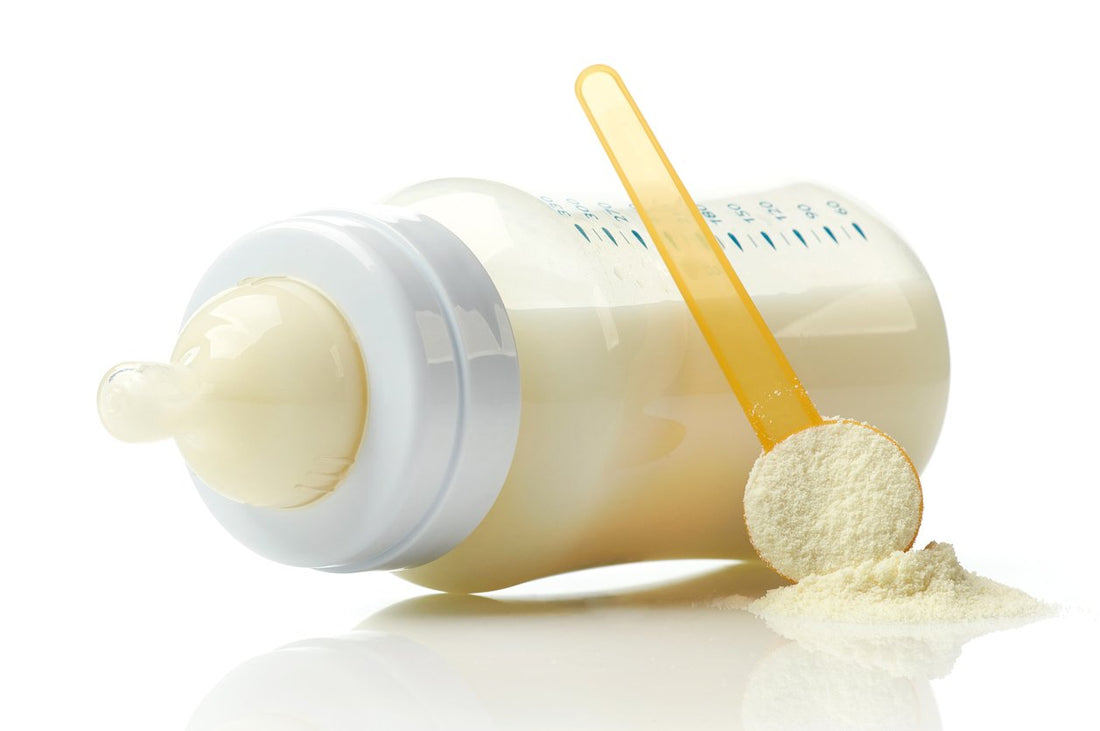Baby Formula: How to Make the Best Decision

All formulas are not created equal.
In a society of illness, disease, and SAD (Standard American Diet) our infants’ source of nutrients needs to be seriously evaluated. Formula has a great place in this world, allowing babies who wouldn’t receive nourishment the ability to thrive – however, it also has the ability to destroy your infant’s gut, trigger food allergies, asthma, increase risks of diabetes, obesity and so many other horrible things. So selecting wisely is key.
Remember that as a baby grows and develops, her nutritional needs grow as well. When breastfeeding, your milk naturally adapts as baby grows, but formula does not. Make sure to keep this in mind and know that you may need to supplement with vitamins, change formulas or add in other options. This should be discussed with your pediatrician, but know that doctors are not properly educated in formula and their ingredients, so you will have to do the leg work and hope for an open discussion.
Similac, Enfamil, and Gerber Good Start, who combined account for more than 90% of all infant formula sales in the United States, are exposing our babies to potentially grave health risks by using genetically modified ingredients. Babies are particularly vulnerable when it comes to consuming GMO’s as their digestive and immune systems are not fully developed and GMO crops have an extremely high exposure to dangerous pesticides and herbicides (like RoundUp).
Infant livers do not reach maturity until about two years of age and cannot process toxins in the body well. GMO’s are not the only scary ingredient to worry about: traces of pesticides, milk contaminated with antibiotics and growth hormones, and oils extracted with hexane are all commonly found in formula.

Let’s breakdown the ingredients in most American baby formulas: (Taken from Similac)
The first two ingredients are corn syrup and sugar, with corn syrup making up 42.6% of each serving. This is NOT okay for our precious young ones to be consuming. Milk proteins, oils, and soy round out the list. There is nothing in this that is even a true food. (The saddest part is that these are the ingredients in the formula brands handed out by hospitals.) There are also the ingredients that are not labeled or labeled under names a non-scientist would never understand: (source)
- Aluminum: present in soybeans and other additives used to make formula, interferes with cellular metabolic processes and information transfer from DNA. Aluminum is found in very high concentrations in soy formula, some of the hypoallergenic formulas, and some of the preterm infant formulas. This is of concern because of the possibility of increased amounts of aluminum being deposited into the brain and the resulting risk of brain dysfunction. Standard formulas can contain up to 40 times the amount of aluminum found in breastmilk.
- Silicon: The effect of large amounts of silicon on an infant is unknown. 55.45ng/ml in milk of mothers with silicone implants 51.05ng/ml in milk of mothers without implants 746-13,811 ng/ml in 26 brands of formula tested for silicon
- Genetically Engineered Ingredients: Several brands of formula have tested positive for genetically engineered corn and soy. We know today that 55% of the United State's soy crop and 35% of the corn crop is currently genetically engineered. Neocare and Isomil products, Ross Labs' Similac, Carnation's Alsoy product, and Mead Johnson's ProSoBee formula all tested positive for GE ingredients. GE ingredients pose the risk of introducing novel toxins, new allergens, and an increased antibiotic resistance to infants. Because the FDA does not require labeling of GE foods, parents will remain unaware that their baby is consuming transgenic ingredients.
- MSG: (monosodium glutamate, or processed free glutamic acid and processed free aspartic acid) is a known neurotoxin found in a number of infant formulas. Because the blood brain barrier is not fully developed in infants, these neurotoxins are more accessible to the infant brain than the adult brain. The highest levels of these neurotoxins were found in hypoallergenic formulas. Because no studies have been done on the long-term outcomes of infants fed on hypoallergenic formulas, it's unknown if they will exhibit more learning disabilities at school age, and/or more endocrine disorders such as obesity and reproductive disorders later in life.
- Isoflavones: Phytoestrogens are endocrine disruptors found in soybeans. Infants fed soy formula have circulating phytoestrogen concentrations that are 13,000 to 22,000 times higher than levels normally found in early life. These bioactive compounds can create steroid hormone imbalance, compete with enzymes that metabolize steroids and drugs, and can affect gonadal (sex organ) function. Soy formula has, for example, been linked to premature thelarche (breast development in infants and girls under eight years of age). Phytoestrogens also have an effect on the thyroid gland. They're well-known inducers of goiter and antithyroid agents. They act against the thyroid by inhibition of thyroid peroxidase. Children with autoimmune thyroid disease were three times more likely to have been fed soy formula in infancy.
- Soy: Soy formula is usually only recommended if a baby suffers from dairy intolerance. If you’re buying non-organic formula, the soy is likely genetically modified. Synthetic l-methionine is added to soy formula to meet nutrition requirements, but because it is produced with things like hydrogen cyanide and other air pollutants, it is prohibited in European organic foods
- Preservatives (linked to health issues, neurological issues, etc), Carrageenan (linked to cancer), and synthetic nutrients are also included.
Side effects of non-organic versus organic:
- Sleep: Hard to digest formula will have baby sleeping longer hours, as the body needs more time to work to digest. Remember that the infant stomach is NOT large. It needs to be nourished every few hours, and baby SHOULD wake up to eat.
- Head Size: Formula-fed babies tend to have larger heads due to the steroids found in the formula. Organic or non-steroid containing formulas should not cause this issue.
- Schedule: Chemical-filled formulas allow baby’s stomach to stretch and fill for longer periods on time. It is full of “fillers.” A good formula will allow baby to be hungry again sooner.
- Bowel Movements: A good formula should NOT be constipating.
Top Formula Choices
(We are NOT affiliated with any formula company)
Baby’s Only Organic Formula
Made by Nature’s One, this is by far the best widely available infant formula option. Baby’s Only is the lone organic formula with a DHA/ARA-free option. And in their formulas that do contain DHA/ARA, they are the only company to use a non-hexane method of extracting the fatty acids, which is FDA-approved (it’s a water process on egg proteins). Baby’s Only formula is made in the USA by a family-owned business that is not publicly traded. Baby’s Only does not contain palm oil. While this formula is marketed towards toddlers, it does receive the FDA’s approval for infant formula; when asked, Nature’s One said they call it a “toddler formula” because they believe babies should all be breastfed for at least the first year and they want to encourage that.
Holle Organic Baby Milk Formula
European brand of formula comes from grass-fed, organic, and biodynamic milk, and does not contain any of the synthetic ingredients that you’ll find in American formulas. It also doesn’t contain soy or corn ingredients.
Here’s an update from July 2015: Lebenswert is a newish formula under the Holle umbrella. The Stage 1 Lebenswert formula is actually better than original Holle because it contains lactose instead of maltodextrin. Unfortunately, Holle doesn’t meet FDA approval, so it’s difficult and expensive to obtain in the U.S. You can still purchase it (including Lebenswert). Order here.
HiPP Baby Milk
Although European HiPP formula does contain palm oil, it is blended with coconut oil. The major upside to HiPP is the lack of plant-based sweeteners (it uses lactose instead). It also contains beneficial prebiotics. The only major concern with HiPP is the powder variety of its formula was found to have high aluminum levels. (So go with the ready-made version.) As with Holle, HiPP can be hard to purchase in the U.S. and expensive to have shipped from Europe. But you can purchase from the above link. Organic does not always mean safe, but it is better than non-organic.
The sneaky formulas that want you to think they are the best:
Bright Beginnings Organic Formula, owned by pharmaceutical giant PMB, it contains maltodextrin, a plant-based sweetener, rather than dairy-based lactose, as well as palm oil.
Earth’s Best Organic Formulacontains organic lactose, glucose syrup solids (corn syrup solids, a cheap substitute for lactose), as well as palm oil and carrageenan.
Parent’s Choice Organic Formula contains maltodextrin, as well as all the other bad stuff.
Similac Organic Formulais the only organic formula to contain actual cane sugar, and lots of it. Their ready-to-use formula also contains carrageenan. The only upside? Similac is free of palm oil.
Vermont Organics Formula, also owned by PMB Nutritionals, contains palm oil, hexane-extracted DHA/ARA, and organic glucose syrup solids (corn).
Whole Foods 365 Organic Formula, also produced by PMB, contains palm oil and corn-based sugars.
**No matter what formula you select, make sure YOU FILTER YOUR WATER before mixing**
Bottle selection also plays a role in baby’s health: The possibility of Phthalates and bisphenol-A, industrial chemicals that disrupt the endocrine system Phthalates, leaching from the plastic bottle into the formula can be ingested by the baby. The decision to use formula is a tough one to make, and choosing your formula is even harder. Please realize that brands are not created equal.







